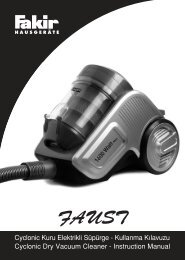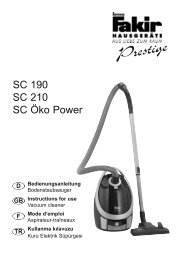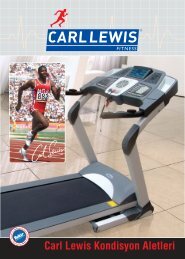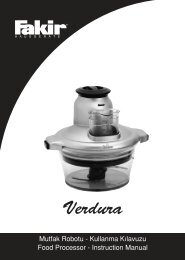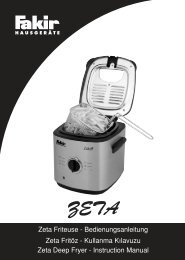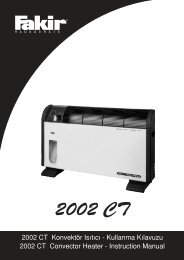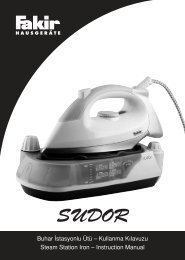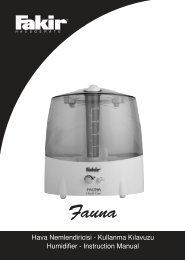kullanma kılavuzu için tıklayınız. - Saruhan Makina ve Elektrikli Ev ...
kullanma kılavuzu için tıklayınız. - Saruhan Makina ve Elektrikli Ev ...
kullanma kılavuzu için tıklayınız. - Saruhan Makina ve Elektrikli Ev ...
Create successful ePaper yourself
Turn your PDF publications into a flip-book with our unique Google optimized e-Paper software.
BPM100<br />
Tansiyon Ölçer<br />
Tansiyon Ölçer - Kullanma K›lavuzu<br />
Wrist Blood Pressure Monitor - Instruction Manual
Girifl<br />
Fakir – BPM 100 tansiyon ölçeri satın almıfl oldu¤unuz için sizi kutlarız.<br />
Sizlere uzun süre gü<strong>ve</strong>nle hizmet <strong>ve</strong>rmek için tasarlanmıfl bu ürün kolay<br />
kullanımlıdır. Benzer ürünleri daha önce kullanmıfl olabilirsiniz, ancak<br />
cihazı <strong>kullanma</strong>dan önce <strong>kullanma</strong> kılavuzunu mutlaka okuyunuz. Bu<br />
kılavuz, satın almıfl oldu¤unuz üründen en iyi performansı almanız için<br />
tasarlanmıfltır.<br />
Cihaz ile ilgili oluflabilecek her türlü problem <strong>ve</strong> arıza ile ilgili olarak Fakir<br />
Yetkili Servisine baflvurunuz.<br />
Gü<strong>ve</strong>nlik önemlidir. Kendinizin ya da di¤er kiflilerin gü<strong>ve</strong>nli¤i için, cihazı<br />
<strong>kullanma</strong>dan önce gü<strong>ve</strong>nlik uyarılarını mutlaka okuyunuz.<br />
Bu kılavuzu ilerideki kullanımlar için saklayınız.<br />
BPM100 TANS‹YON ÖLÇER<br />
Fakir BPM100 otomatik olarak atardamarlardaki kan bas›nc› de¤erini<br />
(büyük <strong>ve</strong> küçük tansiyon) <strong>ve</strong> kalp at›fl›n› ölçer. Kan bas›nc› atardamarlardan<br />
geçen kan›n ak›fl gücüne göre ölçülür.<br />
Bu ak›fl›n süreklili¤i bize kalp at›fl›n› (nab›z) <strong>ve</strong>rir.<br />
Tansiyon kan›n damar duvar›n› zorlamas›d›r. Kalp, kas›l›p kan›<br />
pompalad›¤›nda, atardamar duvar›n›n gerginli¤i en yüksek seviyededir.<br />
Buna sistolik (büyük) tansiyon denir. Kalp gevfledi¤inde ise atardamar<br />
duvar›ndaki gerginlik daha düflüktür. Buna diastolik (küçük) tansiyon denir.<br />
Kan bas›nc›n› etkileyen bir çok faktör vard›r; sigara, stres, fiziksel<br />
aktiviteler, yemek...<br />
Kendi kendinize do¤ru <strong>ve</strong> kolay tansiyon ölçümü için bu aleti kullanabilirsiniz.<br />
<strong>Ev</strong>de belirli aral›klarla tekrarlanarak yap›lan ölçümler size tansiyonunuzu<br />
kontrol etmenizde yard›m edecektir.
GÜVENL‹K UYARILARI<br />
C‹HAZINIZI KULLANMADAN ÖNCE BU KULLANMA KILAVUZUNU<br />
D‹KKATL‹CE OKUYUNUZ VE DA‹MA SAKLAYINIZ.<br />
UYARILAR<br />
• Kendi kendine ölçüm için kullan›l›r, teflhis <strong>ve</strong> tedavi için kullan›lmas› uygun<br />
de¤ildir. Anormal ölçüm de¤erlerini daima doktorunuza dan›fl›n›z. T›bbi<br />
bir ilaç al›yor yada bir tedavi görüyorsan›z, yine doktorunuza dan›flman›z›<br />
önerilir.<br />
• Cihaz kalp pili bulunan kifliler için uygun de¤ildir.<br />
• Hamileyseniz, kalp ritim bozuklu¤u, damar t›kan›kl›¤›, karaci¤er bozuklu¤u,<br />
fleker hastal›¤› gibi rahats›zl›klar›n›z varsa <strong>ve</strong>ya kalp at›fllar›n› düzenleyen<br />
bir ayg›t kullan›yorsan›z, tansiyonunuzu ölçmeden önce doktorunuza<br />
dan›flman›z› öneririz. Çünkü, bu tür rahats›zl›klar belirtilen standart de¤erlerin<br />
d›fl›nda de¤erler elde etmenize sebep olabilir.<br />
• A¤›r damar sertli¤i <strong>ve</strong> benzer hastal›klar› olan, spazm geçirmifl hastalar›n<br />
tansiyon <strong>ve</strong> nab›z ölçümleri için net sonuç <strong>ve</strong>rmeyebilir.<br />
• Cihaz›n›z› Tomografi (TAC), Röntgen, Manyetik Rezonans (RMN) cihazlar›n›n<br />
bulundu¤u yerde <strong>kullanma</strong>y›n›z.<br />
• Cihaz›n›z› kullan›m talimatlar› d›fl›nda <strong>kullanma</strong>y›n›z.<br />
3
1. E¤er kolda akut yada kronik damar hastal›klar›ndan kaynaklanan yüksek<br />
kan dolafl›m› ak›m› var ise bu ölçümün do¤rulu¤unu etkileyecektir.<br />
2. Kalp rahats›zl›klar›nda ölçümler de¤iflebilir. Ayn› durum düflük tansiyon,<br />
kans›zl›k, ritim bozuklu¤u gibi di¤er ufak patolojik rahats›zl›klarda da<br />
görülebilir.<br />
3. Cihaz›n›z› güçlü manyetik alanlarda <strong>kullanma</strong>y›n›z. Cihaz, radyo<br />
araçlar›/al›c›lar› <strong>ve</strong>ya cep telefonlar›ndan uzak tutulmal›d›r.<br />
4. Tansiyon kifliden kifliye <strong>ve</strong> gün içinde strese ba¤l› olarak sürekli de¤ifliklik<br />
gösterir. Normal olarak tansiyon gece, uykuda iken, dinlenirken düflük<br />
seviyelerdedir. Tam tersi sinirli, endifleli iken, sigara içerken <strong>ve</strong>ya fiziksel<br />
egzersiz yaparken tansiyon yüksek seviyelerdedir. Tansiyon yafla <strong>ve</strong><br />
yaflam tarz›na göre de¤ifliklik gösterir. Stres, obezite, yüksek oranda tuz<br />
<strong>ve</strong> alkol kullan›m› tansiyonu yükseltir.<br />
5. Bu cihaz sadece ev kullan›m› içindir. Cihaz›n›z› <strong>ve</strong> pilleri çocuklar›n<br />
eriflebilece¤i yerlerden uzak tutunuz.<br />
4
ÜRÜN ÖZELL‹KLER‹<br />
1<br />
6<br />
5<br />
8<br />
4<br />
2<br />
7 3<br />
9<br />
1) LCD EKRAN<br />
2) O/I (AÇMA/KAPAMA) DÜ⁄MES‹<br />
3) HAFIZA DÜ⁄MES‹<br />
4) HAFIZA ALANI SEÇ‹M DÜ⁄MES‹<br />
5) TAR‹H VE ZAMAN AYARLAMA DÜ⁄MES‹<br />
6) AYAR DÜ⁄MES‹<br />
7) KOL BANDI<br />
8) PIL HAZNES‹<br />
9) PILLER<br />
10)SAKLAMA KABI<br />
10<br />
5
TEKN‹K ÖZELL‹KLER<br />
Ölçüm aral›¤›<br />
Do¤ruluk oran›<br />
fiiflme<br />
Güç kayna¤›<br />
Haf›zalar<br />
Çal›flma için ortam ›s›s›<br />
Saklama için ortam ›s›s›<br />
Bileklik geniflli¤i<br />
Cihaz Ebatlar›<br />
Cihaz A¤›rl›¤›<br />
: 40 - 250mmHg (bileklik bas›nc›)<br />
40 - 199 at›fl/dk (nab›z at›fl h›z›)<br />
: -/+ 3mmHg (bileklik bas›nc›)<br />
-/+ 5% ölçüm (nab›z at›fl h›z›)<br />
: otomatik<br />
: 2 alkalin pil, AAA (LR03)<br />
: Her bir haf›za alan› (2 haf›za alan›) için<br />
50 haf›za kapasitesi<br />
: +10 0 C / +40 0 C<br />
en fazla 85% nemli ortam<br />
: -10 0 C / +60 0 C en fazla 85% nemli ortam<br />
: yaklafl›k 135 - 220mm aras›nda.<br />
: 79 x 72 x 71mm<br />
: 130g (pil dahil de¤il)<br />
Önemli! Kullanma k›lavuzunu dikkatli okuyunuz.<br />
BF tipi malzeme<br />
Bu cihaz afla¤›da belirtilen standartlara uygundur:<br />
DIN EN 60601-1: 3/96 “Medikal elektrikli cihazlar”<br />
Part 1: Gü<strong>ve</strong>nlik için beklenen genel hususlar<br />
DIN EN 1060-1: 12/95, AMD 1 09/02 “Non-invasi<strong>ve</strong> sphygmomanometers”<br />
Part 1: Genel gereksinimler<br />
DIN EN 1060-3: 9/97 “Non-invasi<strong>ve</strong> sphygmomanometers”<br />
Part 3: Elektro-mekanik tansiyon ölçme sistemleri için destek gereksinimleri.<br />
6
KULLANIM<br />
Kullan›m Öncesi<br />
Kan bas›nc›n› etkileyen bir çok faktör olabilir: sigara, stres, fiziksel<br />
aktiviteler, yemek...Birçok faktöre ba¤l› olarak tansiyon gün içinde<br />
25/50mmHg de¤ifliklik gösterebilir.<br />
Do¤ru ölçüm için afla¤›daki basamaklar› izleyiniz:<br />
1. Sandalyeye oturun. Rahatlay›n <strong>ve</strong> ölçüme kadar 5/10dk sakin kalmaya<br />
çal›fl›n.<br />
2. Cihaz› bile¤inize takmadan önce kolunuzda herhangi bir tak›, aksesuar<br />
yada giysi olmamas›na dikkat ediniz.<br />
3. Ölçümden önce yemek yememeye, sigara içmemeye <strong>ve</strong> alkol almamaya<br />
dikkat ediniz. Tüm bu faktörler ölçüm sonucunu etkiler.<br />
4. Kolunuzu bir yere dayay›n›z. Alet kalp hizas›na gelecek flekilde kolunuzu<br />
d›flar› do¤ru düzgün bir biçimde bükünüz <strong>ve</strong> pozisyonunuzu koruyunuz.<br />
5. Kolunuzu bir yere dayay›n›z.<br />
6. ‹ki aya¤›n›z› da yere bas›n›z.<br />
7. Tansiyon gün içinde sürekli olarak de¤iflim gösterebilir. Gün için de<br />
tansiyonunuzu belirli zamanlarda (yemekten <strong>ve</strong> spordan sonra, çal›flma<br />
esnas›nda v.b) ölçerseniz daha net sonuçlara ulaflabilirsiniz.<br />
8. Sadece bir ölçüm yapmay›n›z. En az iki ölçüm yap›n›z. Ve iki ölçüm<br />
aras› en az 10/15dk kadar bekleyiniz. Birden fazla ölçüm yapmak size<br />
tansiyon durumunuz hakk›nda daha net sonuçlar <strong>ve</strong>recektir.<br />
9. Ölçüm s›ras›nda kendinizi rahats›z hissederseniz ölçme ifllemini derhal<br />
cihaz›n›zdaki 0/I dü¤mesi ile durdurunuz.<br />
ÖNEML‹ NOTLAR!<br />
• Ölçüm esnas›nda cihaz kalp ile ayn› hizada tutulmal›d›r. Aksi halde<br />
do¤ru sonuç alamazs›n›z.<br />
• Cihaz 18 yafl›n üstündeki yetiflkinlerin tansiyonunu ölçmek için<br />
tasarlanm›flt›r. Çocuklarda kullan›ld›¤›nda do¤ru sonuç <strong>ve</strong>rmeyebilir.<br />
Çocu¤unuzun tansiyonunu ölçmek için doktorunuza baflvurunuz.<br />
• Ölçüm için sol bile¤inizi <strong>kullanma</strong>n›z› tavsiye ederiz.<br />
7
• Cihaz› s›cak <strong>ve</strong> rutubetli bir ortamda kullan›rsan›z limit d›fl› ölçüm<br />
sonucu alabilirsiniz.<br />
P‹LLER‹N DE⁄‹fiT‹R‹LMES‹<br />
1. Pil kapa¤›n› ok yönünde kayd›rarak aç›n›z.<br />
2. Kutup uçlar›na göre pilleri yuvaya yerlefltiriniz.<br />
3. Pil kapa¤›n› tekrar yerine yerlefltirerek kapat›n›z. Pil sembolü ekranda<br />
belirdi¤inde pilleri de¤ifltirme zaman›n›z gelmifl demektir.<br />
4. Ömrü biten piller prosedüre uygun flekilde imha edilmelidir.<br />
ZAMAN / SAAT AYARLAMASI<br />
1. Cihaz üstündeki “ ” dü¤mesine bas›n›z. Ay zaman›n›n yaz›laca¤› boflluk<br />
yan›p sönmeye bafllayacakt›r. De¤eri girmek için “+” dü¤mesine, kaydedip<br />
onaylamak içinde “ ” dü¤mesine bas›n›z.<br />
8
2. fiimdi günü girmek için boflluk yan›p sönmeye bafllayacakt›r. De¤eri girmek<br />
için “+” dü¤mesine, kaydedip onaylamak içinde “ ” dü¤mesine bas›n›z.<br />
3. Saati girmek için boflluk yan›p sönmeye bafllayacakt›r. De¤eri girmek için<br />
“+” dü¤mesine, kaydedip onaylamak içinde “ ” dü¤mesine bas›n›z.<br />
Cihaz›n›z saati 12 zaman dilimi içinde (a.m/p.m) olarak gösterir.<br />
4. Dakikay› girmek için boflluk yan›p sönmeye bafllayacakt›r. De¤eri girmek<br />
için “+” dü¤mesine, kaydedip onaylamak içinde “ ” dü¤mesine bas›n›z<br />
5. Cihaz›n ekran› size saati, dakikay›, haf›za alan›n› <strong>ve</strong> “O”’› gösterir. Art›k<br />
cihaz›n›z ölçüm için haz›rd›r. Cihaz› aç›p kapatmak için 0/I dü¤mesini<br />
kullan›n›z.<br />
C‹HAZIN KULLANIMI<br />
Bu <strong>kullanma</strong> k›lavuzu sa¤ <strong>ve</strong> sol bilek ölçümü için haz›rlanm›flt›r.<br />
Biz yinede ölçüm için sol bile¤inizi <strong>kullanma</strong>n›z› öneririz. Do¤ru sonuç<br />
almak için daima ayn› kol ile ölçüm yapman›z› tavsiye ederiz.<br />
1. Varsa kolunuzdaki saat <strong>ve</strong> mücevherlerinizi ç›kar›n›z. Avuç içi yukar›<br />
bakacak flekilde kolunuzu uzat›n›z. Cihaz› bile¤in iç taraf›na bilekten<br />
yaklafl›k 1cm yukar› yerlefltiriniz.<br />
2. Cihaz› bile¤inize sar›n›z.<br />
3. Cihaz› bile¤inize çok s›k› sarmamaya özen gösteriniz.<br />
TANS‹YON ÖLÇÜMÜ<br />
1. tufluna bas›n›z. Ekranda 1 yada 2 haf›za alan› görünür. ‹stenilen<br />
haf›za alan›n› seçmek için tekrar tufluna bas›n›z.<br />
2. Cihaz sa¤ <strong>ve</strong>ya sol bile¤inizde iken 0/I tufluna bas›n›z. Tüm fonksiyon<br />
sembolleri birkaç saniyeli¤ine ekranda görünecektir.<br />
3. Ekranda “0” göründü¤ünde cihaz ölçüm için haz›r demektir. Bileklik<br />
otomatik olarak fliflecektir.<br />
4. Ölçüm bitti¤inde ekrandan büyük (sistolik) tansiyon, küçük (diastolik)<br />
tansiyon, nab›z, haf›za alan›, haf›za numaras›, saat <strong>ve</strong> tarih bilgilerini<br />
okuyabilirsiniz.<br />
9
Tekrar Ölçüm<br />
E¤er ölçüm esnas›nda kolunuz yada bile¤iniz hareket ederse cihaz ölçüm<br />
yapamayabilir. Bu durumda cihaz tekrar 220mmHg seviyesine kadar<br />
bile¤inize bas›nç uygulayacakt›r. Do¤ru ölçümü yapana kadar cihaz bunu<br />
yapabilir. Bu cihaz›n›z›n bozuk oldu¤u anlam›na gelmez.<br />
5. E¤er herhangi bir nedenle ölçümü durdurmak isterseniz 0/I dü¤mesine<br />
bas›n›z <strong>ve</strong> bileklik bantlar›n› aç›n›z. Cihaz› 0/I dü¤mesini kullanarak<br />
kapatabilirsiniz. Ayr›ca 1dk sonra otomatik olarak kendi kendine kapanma<br />
özelli¤ide vard›r.<br />
HAFIZA ÖZELL‹⁄‹<br />
Bu cihaz her bir haf›za alan›nda 50 ölçüm kayd›n› sakl› tutar (2 haf›za alan›<br />
bulunmaktad›r.). Her ölçümden sonra otomatik olarak flu de¤erleri saklar:<br />
Büyük (sistolik) tansiyon, küçük (diastolik) tansiyon, nab›z, saat, tarih <strong>ve</strong><br />
otomatik hesaplanan ölçüm de¤eri.<br />
Kaydedilen ölçümleri görmek için tufluna bas›n›z. Bir haf›za alan›<br />
seçiniz <strong>ve</strong> “M” tufluna bas›n›z. Tufla her bas›ld›¤›nda kay›tl› <strong>ve</strong>riler ekranda<br />
s›ras›yla görünür. Ekran›n sol alt köflesinde kay›tl› haf›za numaras› görünür.<br />
Numara “50”’i gösterdi¤inde, “1” numaral› ölçüm en eski ölçüm demektir.<br />
Ekranda “A” sembolü göründü¤ünde bunun anlam› son 3 ölçüm<br />
yap›labilece¤idir.<br />
50 ölçümden sonraki ölçümlerde eski <strong>ve</strong>riler otomatik olarak silinecektir.<br />
Cihaz haf›zadaki ölçümleri yaklafl›k 1dk olarak ekranda gösterir. 1dk sonra<br />
kendili¤inden kapan›r.<br />
HAFIZAYI S‹LME<br />
a) Bir haf›za alan›ndaki kay›tl› bütün bilgileri silme.<br />
Hangi haf›za alan›n› silmek istiyorsan›z dü¤mesine basarak seçim<br />
yap›n›z. Ekranda “O SYS O DIA O PULSE O mem.” yaz›s› ç›kana kadar<br />
“M” dü¤mesine bas›n›z. Böylece seçti¤iniz haf›za alan›ndaki kay›tl› bilgiler<br />
silinmifl olacakt›r.<br />
10
Zaman<br />
Büyük (Sistolik)<br />
Tansiyon<br />
Haf›za Alan›<br />
Küçük (Diastolik)<br />
Tansiyon<br />
Haf›za<br />
Nab›z<br />
YET‹fiK‹NLER ‹Ç‹N TANS‹YON DE⁄ERLER‹<br />
(ÖLÇÜ B‹R‹M‹ mmHg) SINIFLAMASI<br />
ALAN Büyük (Sistolik) Küçük (Diastolik) SONUÇ<br />
Tansiyon Tansiyon<br />
Düflük tansiyon 105’den az 60’dan az doktorunuza dan›fl›n<br />
Normal tansiyon 105 - 140 60 - 90 normal de¤er<br />
Yüksek tansiyon s›n›r› 140 – 160 90 – 95 doktorunuza dan›fl›n<br />
Yüksek tansiyon 160’dan yüksek 95’den yüksek doktorunuza dan›fl›n<br />
11
) Her iki haf›za alan›ndaki kay›tl› bütün bilgileri silme.<br />
Cihaz›n›z›n pillerini de¤ifltirirken otomatik olarak haf›zalardaki bütün bilgiler<br />
silinecektir.<br />
GÖSTERGELER<br />
Afla¤›daki semboller cihaz›n›z›n ekran›nda görülebilir:<br />
1 : MEMORY AREA No.1: Ölçüler 1 numaral› haf›za alan›na kaydedildi¤i<br />
zaman görünür.<br />
2 : MEMORY AREA No.2: Ölçüler 2 numaral› haf›za alan›na kaydedildi¤i<br />
zaman görünür.<br />
EE: kolunuzu hareket ettirdi¤inizde, yanl›fl ölçme pozisyonunda yanl›fl<br />
ölçüm yap›lmas›na neden olacak durumlarda görünür. Do¤ru ölçüm için<br />
“DO⁄RU ÖLÇÜM YÖNTEMLER” bölümüne bak›n›z.<br />
P‹LLER BOfi: Piller yetersiz yenisini tak›n›z.<br />
12<br />
: Nab›z sembolü<br />
Mem: Her bir ölçüm için ilerleyici haf›za numaras› belirlenece¤i zaman<br />
görünür.<br />
TEM‹ZL‹K VE BAKIM<br />
• Bu cihaz hassas parçalardan oluflmaktad›r. Bu nedenle, afl›r› s›cakl›ktan,<br />
rutubetten, tozdan, direk günefl ›fl›¤›ndan, vurma <strong>ve</strong> çarpmalardan<br />
korunmal›d›r.<br />
• Cihaz› kuru yumuflak bir bezle temizleyiniz. Temizlik için herhangi bir<br />
kimyasal madde <strong>kullanma</strong>y›n›z. Cihaz›n s›v› ile temas etmemesine özen<br />
gösteriniz.<br />
• Cihaz suya karfl› dayan›kl› de¤ildir.<br />
• Cihaz daima kendi kab›nda saklay›n›z.
ÖZEL DURUMLAR<br />
Afla¤›daki sorunlar›n oluflmas› durumunda:<br />
1) “0/I dü¤mesine bast›¤›n›zda cihaz ölçüm ifllemine bafllam›yorsa.<br />
• Pilleri kontrol ediniz, gerekliyse yenilerini tak›n›z.<br />
• Pil yuvas›n› kuru bir bezle temizleyiniz.<br />
2) Haf›za dü¤mesine bas›ld›¤›nda ekranda bir fley görünmüyorsa.<br />
• Kaydedilen <strong>ve</strong>riler silinmifl demektir.<br />
3) Piller uzun sure dayanm›yorsa.<br />
• Daha iyi <strong>ve</strong>rim alabilmek için alkalin pil kullan›n›z. Normal zinc-karbon<br />
pil kullan›rsan›z daha s›k pil de¤ifltirme gere¤i duyacaks›n›zd›r.<br />
4) Ekranda hiçbir fley belirmiyorsa.<br />
• Pilleri kontrol ediniz, gerekliyse yenilerini tak›n›z.<br />
5) Tansiyon ölçüm de¤erleri aras›nda bariz bir fark var ise (tansiyon çok<br />
yüksek <strong>ve</strong>ya çok düflük).<br />
• Ölçüm pozisyonunuz do¤ru de¤ildir. “Do¤ru Ölçüm Yöntemler” paragraf›n›<br />
tekrar okuyunuz.<br />
• Strese <strong>ve</strong> gün içindeki saate ba¤l› olarak tansiyon gün içinde de¤iflebilir.<br />
“Uyar›” <strong>ve</strong> “Önemli Notlar” k›s›mlar›n› tekrar okuyunuz.<br />
6) Kalp at›fl› çok yüksek yada alçak okunuyorsa:<br />
• Ölçüm esnas›nda hareket etmifl olabilirsiniz.<br />
• Fiziksel bir aktiviteden sonra ölçüm yapm›fl olabilirsiniz.<br />
“DO⁄RU ÖLÇÜM YÖNTEMLER‹” <strong>ve</strong> “UYARILAR” k›s›mlar›n› tekrar<br />
okuyunuz.<br />
13
1<br />
6<br />
5<br />
7 3<br />
8<br />
4<br />
2<br />
9<br />
COMPONENTS<br />
1) LCD DISPLAY<br />
2) O/I KEY<br />
3) MEMORY KEY<br />
4) MEMORY AREA SELECTION KEY<br />
5) DATE/TIME SETTING KEY<br />
6) KEY + (SETTING)<br />
7) ARMBAND<br />
8) BATTERY COMPARTMENT<br />
9) BATTERIES<br />
10)CASE<br />
10<br />
14
Time<br />
Systolic Value<br />
Memory Area<br />
Diastolic Value<br />
Memory<br />
Pulse<br />
15
BPM100 WRIST BLOOD PRESSURE MONITOR<br />
This fully automatic instrument is used for the non-invasi<strong>ve</strong> measuring<br />
and checking of arterial pressure values (systolic and diastolic) and<br />
heartbeat frequency. Blood pressure is the force exerted by blood on the<br />
arteries.<br />
This force varies constantly depending on heartbeat.<br />
When the heart contracts, blood pressure is at its highest (systolic blood<br />
pressure value) whilst at the end of the heart’s “relaxation period”, the<br />
value is at its lowest (diastolic blood pressure value).<br />
Blood pressure is influenced by many factors: smoke, stress, physical<br />
activity, eating, the time of day…<br />
Accurate and easy to use, this device enables e<strong>ve</strong>n the elderly and less<br />
expert to measure blood pressure in the comfort of their own home; its<br />
quick and reliable results enabling pressure values to be checked daily.<br />
BEFORE STARTING TO USE THE DEVICE, PLEASE READ THIS<br />
INSTRACTION MANUEL CAREFULLY FROM COVER TO COVER AND<br />
KEEP IT SAFE FOR FUTURE REFERENCE.<br />
Warning:<br />
• Self-measuring means checking, and is no substitute for diagnosis or<br />
treatment. Unusual values should always be discussed with your doctor.<br />
Under no circumstances should doses of any medicine prescribed by<br />
your doctor be altered.<br />
• The heartbeat display is not suitable for checking the frequency of<br />
pacemakers!<br />
• Should there be a deviation from the normal rhythm of the heart (arrhythmia)<br />
or other cardiac problems, for carriers of pacemaker, for those who use<br />
anticoagulants, for women in state of pregnancy, the measurements made<br />
with this device should be evaluated only after consulting your doctor. In<br />
such cases compare the results with the doctor in order to <strong>ve</strong>rify their<br />
correctness.<br />
17
• In case of heavy arteriosclerosis and other circulation problems or spasms<br />
in the upper limbs the reading could result incorrect.<br />
• This device cannot be used within the area interested by radiations of<br />
Computerized Axial Tomography (TAC), X rays and Magnetic Resonance<br />
(RMN).<br />
• This appliance must be used solely for the purpose for which it was<br />
designed and in accordance with the operating instructions. Any other<br />
use shall be considered improper and hence hazardous. The manufacturer<br />
cannot be held responsible for any damage resulting from improper or<br />
incorrect use.<br />
WARNING<br />
1. If there is reduced blood circulation in the arm due to acute or chronic<br />
vascular diseases (including the restriction of the diameter of the blood<br />
<strong>ve</strong>ssels), the precision of the measurement could be affected.<br />
2. In the case of cardio circulatory illnesses, the measurement could be<br />
falsified; the same could happen with <strong>ve</strong>ry low blood pressure, problems<br />
with blood supply, arrhythmia or other pre-pathological conditions.<br />
3. Do not use near to strong magnetic fields. It must be kept well away from<br />
radio equipment or mobile phones.<br />
4. Pressure varies from person to person, and increases or decreases e<strong>ve</strong>ry<br />
day, depending on the stress the heart is subjected to. Normally pressure<br />
is low during the night, during sleep or during relaxation, and it is higher<br />
during the day, when we smoke, during physical exercise, under effort,<br />
when we are anxious or tense. Blood pressure tends to increase with age<br />
and depends greatly on the individual way of life. It is well known that<br />
stress, obesity, excessi<strong>ve</strong> intake of salt and alcohol all contribute to<br />
increase arterial pressure.<br />
5. Keep the batteries out of the reach of children.<br />
18
CLASSIFICATION OF BLOOD PRESSURE VALUES<br />
RANGE SYSTOLIC DIASTOLIC MEASURES<br />
Hypotension below 105 below 60 consult your doctor<br />
Normal 105 - 140 60 - 90 self-measuring<br />
Limit range 140 – 160 90 – 95 consult your doctor<br />
Hypertension o<strong>ve</strong>r 160 o<strong>ve</strong>r 95 consult your doctor<br />
CORRECT MEASURING METHOD<br />
Many factors determine variations in arterial pressure: physical<br />
exercise, eating, agitation, changes in temperature and emotional<br />
stress. Daily fluctuations of 25/50mmHG are common.<br />
In order to get an accurate blood pressure reading, follow the instructions<br />
below:<br />
1. Sit on a chair, relax and try to keep still for at least 5/10 minutes before<br />
taking a reading.<br />
2. Remo<strong>ve</strong> clothing and jewellery from the arm or wrist before applying the<br />
armlet.<br />
3. Avoid eating, smoking and drinking (especially alcohol) before taking the<br />
measurement. All these factors will affect the result of the measurement.<br />
4. Rest the arm on the table so that the armlet is on a le<strong>ve</strong>l with the heart.<br />
The arm must be stretched out naturally and must be kept still.<br />
5. Use the case or a similar object to support the forearm.<br />
6. Place both feet on the ground.<br />
7. Remember that the blood pressure changes during the day. Try to<br />
effect more measurements during the day for better understanding<br />
the reactions of your body to the different moments of your day (after<br />
a physical activity, during the job, after the meals…).<br />
8. Do not take only one measurement. At least two measurements should<br />
be taken wait at least 10/15 minutes between the two measurements.<br />
More measurements, taken o<strong>ve</strong>r a long period of time will gi<strong>ve</strong> you<br />
a better indication of your blood pressure.<br />
19
9. Should an unpleasant feeling occur during the measurement, stop<br />
immediately the device with the 0/I button.<br />
IMPORTANT NOTE!<br />
• The device must be kept at the same height of the heart at all times;<br />
otherwise it is not possible to get accurate measurements.<br />
• This unit is designed to measure adult pressure values to be used<br />
for people of 18 years and o<strong>ve</strong>r. If this instrument is applied to the<br />
arm of a child, the value measured may be inaccurate. Consult your<br />
doctor for measuring the arterial pressure of child.<br />
• We recommend using the left arm for taking the measurements.<br />
• If the appliance is used in temperature and humidity conditions outside<br />
the limits gi<strong>ve</strong>n in the “Technical Features” the reading may not be<br />
accurate.<br />
INSERTING/REPLACING BATTERIES<br />
1. Slide the battery co<strong>ve</strong>r in the direction of the arrow.<br />
2. When installing or replacing the two batteries, insert them in accordance<br />
with the polarity marked.<br />
3. Refit the co<strong>ve</strong>r. When the battery symbol appears on the display, the<br />
batteries must be replaced as they are flat. Remo<strong>ve</strong> the batteries whene<strong>ve</strong>r<br />
the instrument is not going to be used for a long time.<br />
4. Used batteries must be disposed of in the specific waste disposal units.<br />
DATE/TIME SETTING<br />
1. Press the “ ” key on the display it blinks the number corresponding to<br />
the month. Use the key “+” to adjust the value and then press the key “ ”<br />
to confirm it.<br />
2. Now, the day indication blinks: Adjust it with the key “+” and confirm it<br />
using the key “ ”.<br />
3. Now the hour indication blinks: Adjust using the key “+” and confirm with<br />
the key “ ”. The display shows the time in 12 hour format (a.m./p.m.).<br />
4. Now the minute indication blinks: Adjust it with the key “+” and confirm<br />
it using the key “ ”.<br />
20
5. The display shows hour and minutes, memory area and “0”. The device<br />
is ready to perform the measurement. It is possible to switch on the device<br />
pressing the 0/I key.<br />
APPLYING THE WRIST CUFF<br />
These instructions must be followed in order to take measurements on<br />
either your right or left wrist.<br />
We recommend measuring on the left wrist, but always use the same one<br />
e<strong>ve</strong>n if the right is used.<br />
1. With the palm of your hand facing up, apply the instrument so that the<br />
edge of the cuff is approx. 1cm from your palm.<br />
2. Apply the wrist cuff around your bare wrist and fasten it in place with the<br />
Velcro fastening.<br />
3. The wrist cuff must be snug around your wrist, but not too tight.<br />
HOW TO TAKE MEASUREMENTS<br />
1. Press the key. The display shows the memory area 1 or 2 . To<br />
select the wished memory area, press the key again.<br />
2. Once the unit is in place on your right or left wrist, press the 0/I key. All<br />
function symbols come up on the display for just a few seconds.<br />
3. When the display reads “0”, the unit is ready to start measuring. The cuff<br />
will start inflating automatically.<br />
4. The following values appear on the display: Systolic value, diastolic value,<br />
pulse, memory area, memory number, date and time of the measurement.<br />
Try to stay relaxed, without talking or moving.<br />
Automatic re-pressurisation<br />
If the pre-set pressure is insufficient in the preliminary reading phase or<br />
the hand or wrist is mo<strong>ve</strong>d, the unit will start inflating again until 220mmHg<br />
are reached. Automatic re-pressurisation is repeated until a valid reading<br />
taken. Howe<strong>ve</strong>r this is not sign of a fault with the appliance.<br />
21
5. If you want to stop measuring for any reason, simply press the 0/I key and<br />
remo<strong>ve</strong> the cuff. The unit switches off automatically if it is left idle for 1<br />
minute, otherwise you can switch it off by pressing the 0/I key.<br />
MEMORY FUNCTION<br />
This device can store up to 50 measurements in each memory area (there<br />
are 2 memory areas). After each measurement, the following values are<br />
stored automatically: Diastolic value, systolic value, pulse, date, time and<br />
automatic calculation of the measured values.<br />
To call up stored measurements, it is necessary to press the key to<br />
select one’s own memory area and then press the key M. (Each pressure<br />
of the key makes the stored data scroll.) On the corner bottom left of the<br />
display the memory number appears.<br />
Number “1” corresponds to the oldest measurement, while number “50”<br />
indicates the most recent value.<br />
When the “A” symbol appears on the display, it means the a<strong>ve</strong>rage of the<br />
last 3 performed measurements is shown.<br />
After the first 50 measurements for each area, the oldest data are erased<br />
automatically.<br />
The stored measurements are displayed for about 1 minute.<br />
After about 1 minute from releasing the M key, the device switches off.<br />
ERASING THE MEMORY<br />
a) Deleting all data stored in a memory area<br />
Press the key to select the memory area in which measurements shall<br />
be erased. Then keep the M key pressed until the display shows “O SYS<br />
O DIA O PULSE O mem.”. Now, all data concerning the previously selected<br />
memory area ha<strong>ve</strong> been erased.<br />
b) Deleting all data stored in both memory areas<br />
When the batteries are replaced, all the reading in both memories are<br />
22
automatically cancelled.<br />
INDICATORS<br />
The following symbols may appear on the display:<br />
1 : MEMORY AREA No.1: it appears when the measurement is stored<br />
in the first memory area.<br />
2 : MEMORY AREA No.2: it appears when the measurement is stored<br />
in the second memory area.<br />
EE: no measurement could be taken as the arm mo<strong>ve</strong>d, incorrect position,<br />
other …. see section entitled “CORRECT MEASURING METHOD”.<br />
EMPTY BATTERY SYMBOL: batteries finished. Replace batteries.<br />
:Pulse frequency symbol.<br />
Mem: progressi<strong>ve</strong> memory number assigned to each measurement<br />
CARE AND MAINTENANCE<br />
• This unit contains precision components. Hence, care must be exercised<br />
to avoid exposing the unit to extreme change in temperatures, humidity,<br />
knocks, dust and direct sunlight. Do not drop or hit the unit.<br />
• Clean the unit using a soft, dry cloth only. Do not use any chemical or<br />
abrasi<strong>ve</strong> product to clean the monitor. Ensure that no liquids enter the<br />
appliance.<br />
• This appliance is not waterproof.<br />
• Place the device in the supplied case and, to store it, obser<strong>ve</strong> the<br />
environmental conditions stated here below.<br />
SPECIAL CASES<br />
If the following circumstances occur:<br />
1) After pressing the 0/I key the reading does not start.<br />
• Check the batteries and replace them if needed.<br />
• Clean the contacts of the batteries with a dry cloth.<br />
23
2) Nothing appears on the display when the MEMORY key is pressed.<br />
• The stored data ha<strong>ve</strong> been deleted.<br />
3) The batteries do not last long.<br />
• Use alkaline batteries to increase working autonomy. If normal zinccarbon<br />
batteries are used they will need changing more often.<br />
4) You cannot complete a reading.<br />
• Check the batteries and change them if needed.<br />
5) The blood pressure le<strong>ve</strong>ls are different with each reading - the readings<br />
are <strong>ve</strong>ry low or <strong>ve</strong>ry high.<br />
• The measuring position is not correct – Read the paragraph “Correct<br />
measuring position” again.<br />
• The blood pressure readings vary constantly depending on the time of<br />
day and the state of ner<strong>ve</strong>s of the person. Read the paragraphs “Warnings”<br />
and “Important” again.<br />
6) The heart beat readings are too high or too low:<br />
• The person mo<strong>ve</strong>d while the reading was being taken.<br />
• The reading was taken after physical exertion. Read the paragraphs<br />
“CORRECT MEASURING METHOD”, “WARNINGS” again.<br />
COMPONENTS<br />
1) LCD DISPLAY<br />
2) O/I KEY<br />
3) MEMORY KEY<br />
4) MEMORY AREA SELECTION KEY<br />
5) DATE/TIME SETTING KEY<br />
6) KEY + (SETTING)<br />
7) ARMBAND<br />
8) BATTERY COMPARTMENT<br />
9) BATTERIES<br />
10)CASE<br />
24
TECHNICAL FEATURES<br />
Pressure indication range : between 40 and 250mmHg<br />
(arm cuff pressure)<br />
between 40 and 199 pulsations/min.<br />
(pulse frequency)<br />
Precision<br />
: -/+ 3mmHg (arm cuff pressure)<br />
-/+ 5% of the read value<br />
(pulse frequency)<br />
Inflating and deflating : automatic<br />
Power supply<br />
: 2 alkaline batteries type AAA (LR03)<br />
Memories<br />
: 50 Memories for each area (2 areas)<br />
Working conditions : between +10 0 C and +40 0 C<br />
85% relati<strong>ve</strong> humidity or lower<br />
Storage conditions : between -10 0 C and +60 0 C<br />
85% relati<strong>ve</strong> humidity or lower<br />
Wrist circumference : between 135 and 220mm approx.<br />
Dimensions<br />
: 79 x 72 x 71mm<br />
Weight<br />
: about 130g (without alkaline batteries)<br />
Important! Read the instructions carefully.<br />
Type BF apparatus<br />
This device conforms to the following standards:<br />
DIN EN 60601-1: 3/96 “Medical electrical equipment”<br />
Part 1: General requirements for safety<br />
DIN EN 1060-1: 12/95, AMD 1 09/02 “Non-invasi<strong>ve</strong> sphygmomanometers”<br />
Part 1: General requirements<br />
DIN EN 1060-3: 9/97 “Non- invasi<strong>ve</strong> sphygmomanometers”<br />
Part 3: Supplementary requirements for electro-mechanical blood pressure<br />
measuring systems<br />
25






